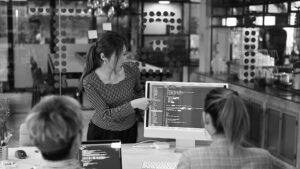Introduction
I am an unabashed adult fan of LEGO (or AFOL, as we refer to ourselves). One of the reasons why is because of The LEGO Group’s very open commitment to making their products and experiences accessible to everyone. The word “LEGO” itself is a combination of two Danish words (“leg” and “godt”) that means “play well.” And that is exactly what LEGO has set out to make sure everyone can do, regardless of their abilities.
Here are 5 lessons LEGO can teach us about accessibility.
Lesson 1: Accessibility should be interwoven throughout the user experience — not an afterthought.
While most people probably associate LEGO with their cornerstone product — their building bricks — the LEGO empire expands beyond the brick and includes several LEGOLAND® theme parks, LEGO Discovery Centers, and the LEGO® House, located near LEGO headquarters in Billund, Denmark. It is clear from their respective websites that accessibility is not an afterthought but rather has been taken into consideration during the creation of the overall experience for many of these attractions.
For example, all of the North American LEGOLAND® locations as well as the Atlanta LEGO Discovery Center have received Certified Autism Center distinctions by the International Board of Credentialing and Continuing Education Standards (IBCCES). The certification process included “staff-wide autism sensitivity and awareness training” and the creation of “sensory guides” for each location that help visitors with different sensory needs plan their experience at the resort. All of this information is readily available on the respective locations’ websites.
The same sentiment is true of the LEGO® House in Denmark. At the top of the accessibility page under the “plan your visit” section of their website, they clearly state: “LEGO® House is available to everyone [and] LEGO® House is designed for full accessibility for all guests.”
What this means for your website: Accessibility is something your organization should go “all-in” on, ideally from the get-go. But that doesn’t mean it’s too late if you’ve already launched a product that isn’t accessible or is only partially accessible (more on that later in this post). Getting to full accessibility is a process, one that takes time and effort. But the payoff is worth it: accessibility benefits not just people with disabilities — in fact, it benefits everyone.
Lesson 2: Making your product, location, or website accessible does not make it less enjoyable for people without disabilities.
Accessibility, by its very nature, expands the user base or audience rather than shrinking it, sometimes in unexpected ways. A classic example is the “curb cut effect.” When the Americans with Disabilities Act mandated that sidewalks have ramps at crosswalks, the intended beneficiaries were people who use wheelchairs and people who have limited mobility. But it soon became clear that people pushing strollers as well as people riding bicycles also benefited from this change.
In much the same way, some of the LEGO theme parks, such as LEGOLAND® New York, offer complimentary PDF Resort Sensory Guides that are marketed as “a resource for guests with cognitive disabilities including autism spectrum disorder (ASD).” These guides provide a detailed breakdown of each attraction by touch, taste, sound, sight, and smell intensity, allowing for guests to plan their park experiences around their specific needs.
But this accessibility feature is actually quite useful beyond its intended audience, as the guide also includes information on strollers and changing tables as well as information for people with allergies and nursing mothers. By housing all of this information benefitting multiple audiences in a single guide, LEGO is helping dispel the notion that people with disabilities should be treated as different and separate from those without disabilities.
What this means for your website: Think about it like this — you wouldn’t make a separate accessible website for people with disabilities and a non-accessible one for people without disabilities. Aside from being time and cost-prohibitive, everyone can benefit from an accessible website — not just people with disabilities.
Additionally, accessible websites are also better for: mobile phone users, people with slow Internet connections, older people whose abilities are changing as they age, people with temporary disabilities (such as broken limbs), etc. By making your website accessible to everyone, your organization can also be a part of the growing effort to break the stigmas surrounding people with disabilities.
Lesson 3: Help destigmatize people with disabilities through your accessibility efforts.
In addition to their extensive work in making their theme parks accessible to people with autism spectrum disorder and other cognitive disabilities, another one of the LEGO Group’s recent accessibility efforts has also made great strides in the movement to destigmatize people with disabilities and increase access to not only their product, but also to an important learning tool with their LEGO® Braille Bricks.
LEGO® Braille Bricks, which were designed in partnership with different blind advocacy organizations from around the world, make braille accessible to blind, partially sighted, and sighted people. Braille is an important tool for literacy and independence in the blind community — some estimates say about ⅓ of adults who are blind in the US are employed, and of those adults, 90% of them read braille.
LEGO® Braille Bricks are also compatible with all other LEGO® bricks, which is, perhaps, the point: at the end of the day, we all just want to sit down and have fun building together.
What this means for your website: Learning about accessibility can be very enlightening to those who may not have experience interacting with people with disabilities. While you are working on making your website accessible, one of the best ways to test for accessibility is through live user testing. In other words, have someone who uses a screen reader or someone who navigates the internet using only a keyboard come in and show you how they would interact with your website. Take in their feedback firsthand. In addition to people with physical disabilities, don’t forget to include people with invisible disabilities.
Lesson 4: Remember that not all disabilities are visible — and people with invisible disabilities have accessibility needs, too.
It should be clear by now that the LEGO Group has worked hard to become an inclusive organization designed with accessibility in mind. But while many organizations often associate accessibility only with physical disabilities and other differences that are easily visually distinguishable, they often let invisible disabilities fall by the wayside. The LEGO Group, however, is not one of those organizations.
The LEGO® House in Billund, Denmark, for instance, offers sunflower lanyards to visitors with invisible disabilities “such as autism, Alzheimer’s, anxiety, mental health conditions, chronic pain, ADHD or PTSD” who may find visiting a busy tourist attraction stressful or overwhelming. Employees are trained to support people with invisible disabilities, and understand that the sunflower lanyard means that the visitor wearing it could need more time, patience, or assistance during their visit.
What this means for your website: Many of the more obvious and frequently flagged accessibility fixes have to do with making websites accessible for people with physical disabilities — usually by making them compatible and navigable with screen readers, increasing text size or color contrast for people with low vision, or including captions or transcripts with audio and video.
While some of these fixes benefit some people with invisible disabilities — people with dyslexia may prefer to use a screen reader, for instance — there are other accessibility guidelines that should be kept in mind. Providing site visitors with the ability to pause rather than autoplay videos — or to hide distracting animations or ads — can make the difference between a person with ADHD or sensory processing difficulties choosing to stay on your organization’s website or navigate away from it.
This may all seem very overwhelming — and you may think you’re being asked to do the impossible in making your website accessible. (It’s not impossible!) The journey may take time, yes, and it may be humbling. That’s why transparency is important.
Lesson 5: Be transparent about your accessibility efforts — as well as your shortcomings, and what you are doing to address them.
On the LEGO® Braille Bricks website you will find a very detailed accessibility statement.
The statement clearly explains:
- Who they worked with to assess the site (the Royal National Institute of Blind People) and against which standards it was assessed (WCAG 2.1)
- What they have done to make the site accessible
- That they know the website is not fully accessible
- How to request information from the site in an alternative format, as well as how to provide feedback or report accessibility issues
- Who to escalate accessibility issues to if you feel your request is not resolved satisfactorily
- In-depth, criteria-specific details about how the site is not fully accessible
- What they are doing to improve the site’s accessibility
- When the site was last audited, when the accessibility statement was reviewed, etc.
But here’s the amazing thing about this page: it doesn’t have to exist at all, let alone in that much detail.
In the United States, federal government agencies are required to provide accessibility statements on their websites. Private companies are encouraged to, but there is no legal requirement to do so. In Europe, the EU’s Web Accessibility Directive requires accessibility statements from “public sector bodies.” It appears that while the LEGO Group, which is based out of Denmark, is not considered a “public sector body” under the EU’s definition, it has nonetheless taken the initiative and provided a detailed accessibility statement on its LEGO® Braille Bricks website.
What this means for your website: The LEGO® Braille Bricks website’s accessibility statement is a shining example of what it looks like to interweave accessibility into your organization’s core — to include it in your processes from the first step; but also to acknowledge that reaching full accessibility takes time; and to be open about that not just in internal communications, but external ones as well.
Conclusion
From their intentional inclusion of accessibility throughout the user experience at the physical locations as well as with their products and on their websites, the LEGO Group has shown that accessibility has widespread benefits beyond those with disabilities while also helping to break down the stigma surrounding disability. They have also taken accessibility for people with invisible disabilities into consideration as well — a group that can be all too easily overlooked. And they have maintained transparency about how far they have come in meeting existing accessibility standards — as well as how far they still have to go.
But your organization does not have to be a global building brick empire like the LEGO Group in order to do any of these things. As this blog post has shown, the core message at the heart of each of the 5 lessons LEGO can teach us about accessibility is one that anyone can put into practice right away: Make a commitment that everyone will be able to “leg godt” (“play well”) with your website, regardless of their abilities.



